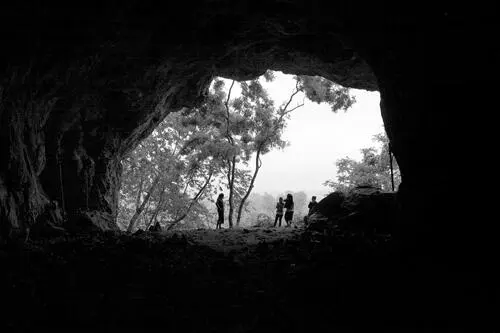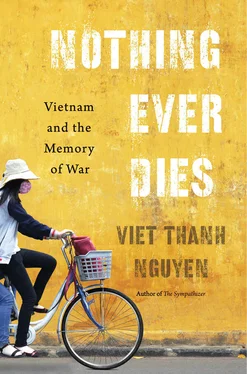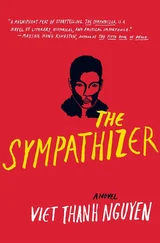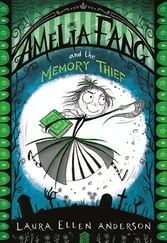The relationship of absence to presence is the invisible dimension of the asymmetry of memory, existing beside the visible dimension of great powers dominating smaller ones. Whether a country is great or small, each one’s war machine and industry of memory seeks to establish control over memory itself. But what is stronger in this asymmetrical relationship, industrial memory or the absent presence of the past? The war machine or the ghost? The war machine seeks to banish ghosts or tame them, but unruly specters abound, if one looks carefully, if one recognizes that spirits exist to be seen by some and not by others. I encountered them in Laos, a country whose mere mention brought light to the eyes of the many Vietnamese who spoke of it as a paradise, so peaceful and calm. In some ways Laos appears to be a satellite of Vietnam, at least in the official Laotian industry of memory, which commemorates Vietnam as the country’s greatest ally. Prominent place is given to the Vietnamese flag and Ho Chi Minh in Vientiane’s museums, which follow much the same narrative as Vietnamese ones. Under the bright lights of industrial memory found in museums such as the Lao People’s Army History Museum, all white walls and chrome handrails, the presence of ghosts is weak. Their presence was likewise vague in the far caves of Vieng Xai in northwest Laos, at least in the daytime hours when I visited. The Pathet Lao took shelter here in a vast and impressive cave complex, greater than anything found in Vietnam, a subterranean metropolis replete with a massive amphitheater carved from rock. Under American bombardment, with the smells of humanity and fear, with the dust and earth falling on one’s head, with electricity faltering, the caves must have been much less tranquil than they are for the tourist whose greatest challenge is adjusting his camera for dim lighting.
Hewn from rock and fashioned into a tourist site, the Vieng Xai caves are industrial memory on a grand scale, a successful attempt to conquer the past, to banish the ghosts. Standing on the amphitheater’s quiet stage, it seemed to me that we did build these memorials to forget, as scholar James Young would have it. 12Many of us want to forget the complexities of the past, as well as its horrors. We prefer a clean, well-lit place that features the orderly kinds of memory offered in the temples of the state, where the line between good and evil is clear, where stories have discernible morals, and where we stand on humanity’s side, the caves within us brightly lit. But even as we memorialize the dead, perhaps what we want to forget most of all is death. We want to forget the ghosts we will become, we want to forget that the hosts of the dead outnumber the ranks of the living, we want to forget that it was the living, just like us, who killed the dead. 13Against this asymmetry of the dead and the living, the industries of memory of countries large and small, of powers great and weak, strive against ghosts. These industries render them meaningful and understandable when possible through stories, eliminating them when necessary. In most cases, though, the industries of memory avoid them. The number of places where the living remember the dead must surely be outnumbered by the places where the dead are forgotten, where not even a stone marks history’s horrors, where there are, Ricoeur says, “witnesses who never encounter an audience capable of listening to them or hearing what they have to say.” 14But what draws our attention are those memorials and monuments, those obelisks and stelae, those parade grounds and battlefields, those movies and fictions, those anniversary days and moments of silence, those outnumbered spaces where the living can command the dead.
Sometimes the ghosts assert their authority, in consecrated spaces of memory yet to be fully industrialized. I did not feel ghosts at Vieng Xai but I did on my way to those caves, on the journey from Phonsavan, when my driver told me I should stop at Tham Phiu. Here, in another mountain cave, an American rocket strike had killed dozens of civilians. This much I knew from my guidebook. I had not intended to stop here, for I was not moved by the prospect of yet another cave of horrors, after the many caves and tunnels that I had already seen. But it was on the way, so why not? There was an exhibition hall, but fortunately I did not see it on my way to the cave. Missing the exhibit meant that I missed the official narrative that would try to tell me what to feel, and what it told me was not surprising, about the innocent civilians and the heartless Americans. The stairs and the handrail were signs enough that the cave had been prepared for tourists, though I was the only one of that kind at the moment. The four schoolgirls I encountered on the way up the mountain were not tourists but locals, making their way leisurely, giggling and snapping pictures of themselves with their phones. I made it to the cave before them, a black mouth through which a truck could be driven. Daylight threw itself a few dozen feet into the recesses, where there was no artificial lighting. There were no steps, no rails, no ropes to guide me over rough ground, unlike the killing caves of Battambang, in Cambodia. Nor, as in Battambang, was there a memorial or a shrine; nor pictures, photographs, placards, or memorials; nor a hungry boy asking to be a tour guide. At Tham Phiu, I was alone in a cave where the local industry of memory, already fragile, stopped at the threshold. I made my way to where light met its opposite and I looked into the darkness. What had it been like with hundreds of people, the noise and the stench, the dimness and the terror? What was in the void now? I stood on the side of presence, facing an absence where the past lived, populated with ghosts, real or imagined, and in that moment I was afraid.

Then I heard the laughter. The girls stood at the cave’s mouth, profiles outlined by sunlight, making sure the shadows did not touch even their toes. Turning my back on all that remained unseen behind me, I walked toward their silhouettes.
AS A CHILD, I WAS ALWAYS AWARE of the presence of the dead. 1Although my Catholic father and mother did not practice ancestor worship, they kept black-and-white photographs of their fathers and their mothers on the mantel and prayed to God before them every evening. I knew the fathers and mothers of my father and mother only through their photographs, in which they never smiled and posed stiffly. In the 1980s, news of my grandparents’ passing into another world arrived one after the other, accompanied by more black-and-white photographs of rural funeral processions marching through a bleak northern landscape, of mourners dressed in simple country clothes and white headbands, of wooden coffins lowered into narrow graves. Visiting the homes of other Vietnamese friends, I paused to study the photographs of their relatives, invariably captured in black-and-white. Every household had these photographs, hallowed signs of our haunting by the past that were emblematic of a lost time, a lost place, and, in many cases, of lost people. For many refugees, the clothes on their backs and a wallet full of photographs were the only things they carried with them on their flight, “the family photograph clutched tight to a chest / When all the rest of the world burns.” 2
In the strange new land in which they found themselves, these photographs transubstantiated into symbols of the missing themselves. Photographs are the secular imprints of ghosts, the most visible sign of their aura, the closest way many in the world of refugees live with those left behind. In le thi diem thuy’s The Gangster We Are All Looking For , the narrator’s mother keeps the only treasured photograph of her own mother and father safe in the attic. When their home is demolished to pave the way for gentrification, the mother forgets to take the photograph with her in the family’s frantic attempt to rescue their belongings. Watching the destruction of her home, the mother calls out to her lost parents, “Ma/Ba.” The narrator, a child, listens to her mother’s cry and thinks of the world as “two butterfly wings rubbing against my ear. Listen … they are sitting in the attic, sitting like royalty. Shining in the dark, buried by a wrecking ball. Paper fragments floating across the surface of the sea. There is not a trace of blood anywhere except here, in my throat, where I am telling you all this.” 3
Читать дальше













